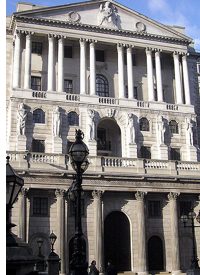
The long-awaited announcement of another bout of money printing in England on this Thursday will prove once again that experience doesn’t modify behavior on the other side of the pond either. The initial round of money expansion, called Quantitative Easing (QE) in the States, of some $320 billion last year in the United Kingdom had little measurable effect.
And so another boost of $80 billion is expected in Thursday’s announcement. This round, according to George Buckley, a UK economist at Deutsche Bank, might not be the last: “If sentiment and activity hold up this could…be the last round of QE, although the fragile nature of the recovery and the situation in Europe could mean [that] the programme continues after May.”
The trouble is that “sentiment and activity” is slowing, pushing England’s GDP into negative territory with downward revisions for the balance of the year expected. The British Office for National Statistics reported “negative growth” (American translation: decline) of 0.2% in the last three months of 2011, and there is little hope for any change in direction for at least the next two years.
Roger Bootle, writing for the British paper The Telegraph, wondered out loud what good additional printing would do. He asked rhetorically three weeks ago, “Once it has completed the current authorized dollop, the Bank of England (BoE) may soon conduct yet more QE. But should it? Or is the current dosage already a danger to us all?”
Bootle then explains, correctly, the process by which the BoE expands the money supply without actually printing more currency:
QE happens through the Bank buying financial assets in the markets with newly created electronic money. In essence, it pays for its purchases by crediting the accounts of the seller’s banks with itself. [Emphasis added.]
This is standard Keynesian response to a stagnant and declining economy. Bootle calls it “an act of monetary policy, designed to stimulate the economy. And, when the time comes, it can be reversed.” He then explains that with this newly-created digital money the banks should be eager to invest it. After all, what is the rate of return on money loaned out at interest that cost nothing? Answer: infinite!
But Bootle can’t figure out why it isn’t working: “Against all expectations, the effects of QE so far have been disappointing…the banks have been happy to sit on the increased deposits” rather than loaning them out.
Adam Posen is a member of the Monetary Policy Committee of the Bank of England, the equivalent of the Fed’s Open Market Committee. And he can’t understand why the banks aren’t lending out these free, no-cost reserves either. In a recent interview Posen lamented: “We, the British taxpayer, but also the British government as a regulator, [are] not getting value for money because the role of banks…is to provide credit for growth of the real economy in the UK and they are not doing the job.” He has the answer, of course: “We’ve got to change the competitive pressures on them, change the rules on them, so they’re forced to do the job right.”
All this forcing and stimulating and creating and digital printing of additional reserves hasn’t helped, as reported by the British think tank the National Institute of Economic and Social Research in January. Their analysis shows that today’s “recovery” in Britain is worse than its rebound in the Great Depression. Four years into the Great Depression the UK economy had turned positive and was accelerating. Today its economy is determinedly negative.
Keynesian economist Paul Krugman noted the obvious: “Four years into the Depression, British GDP had regained its previous peak; four years after the Great Recession began, Britain is nowhere close to regaining its lost ground.”
Krugman blamed the lack of resiliency on “austerity” imposed by the British government without giving his readers one single example of where that government has cut spending. It must be the “confidence fairy” that’s keeping banks from lending and businesses from borrowing. Krugman quoted another Keynesian, Jean-Claude Trichet, who actually said something intelligent about the matter when he was head of the European Central Bank:
I firmly believe that in the current circumstances confidence-inspiring policies will foster and not hamper economic recovery, because confidence is the key factor today.
Krugman laughed out loud at such an absurd statement, writing that “such invocations of the confidence fairy were never plausible,” and that what was needed was more stimulus spending of currency created out of digits.
All of which goes to show how disconnected from reality these experts and managers really are. Confidence in the future and predictability of outcomes are what entrepreneurs need in order to make the gambles and take the risks that drive the economy. Soaking the economy with waves of reserves created out of the ether in hopes that such fake currency will somehow cause real capital to be invested hasn’t worked, cannot work, and will not work. The Fed has proved that here in the United States. The Bank of England is proving it once again over there.
Photo: Bank of England headquarters on Threadneedle Street in London



